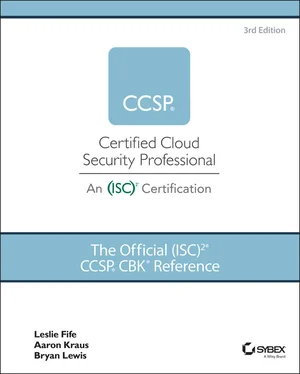1 ...8 9 10 12 13 14 ...18 The second component of availability is concerned with the elasticity and scalability of the cloud service. If the CSP has not properly planned for expansion, a customer may need to grow their use of the contracted service, and the resources may not be available. Consider a service like Dropbox. If the customer pays for 2TB of storage and it is not available, when they need it, the service fails in terms of availability, even if access to files already stored with the service continues to be provided.
Cloud security is a challenging endeavor. It is true that the larger CSPs spend resources and focus on creating a secure environment. It is equally true that a large CSP is a large target, and there are aspects of cloud computing, such as multitenancy, that create new complexities to security.
One issue that is part of various national laws such as the European Union's General Data Protection Regulation is the restriction on cross-border transfers of data. In an environment where the actual hardware could be anywhere, it is an important consideration to know where your data resides. When there are law enforcement issues, location of the data may also be a jurisdictional challenge.
The owner of data remains ultimately responsible for the security of the data, regardless of what cloud or noncloud services are used. Cloud security involves more than protection of the data but includes the applications and infrastructure.
The involvement of third-party providers, in an off-premises situation, creates challenges to data protection and privacy. The end user cannot always determine what controls are in place to protect the privacy of their data and must rely on privacy practice documents and other reports to determine if they trust the third party to protect their data privacy.
Privacy concerns include access to data both during a contract and at the end of a contract as well as the erasure or destruction of data when requested or as required within the contract. Regulatory and contractual requirements such as HIPAA and PCI are also key concerns. Monitoring and logging of data access and modification, and the location of data storage, are additional privacy concerns.
Resilience is the ability to continue operating under adverse or unexpected conditions. This involves both business continuity and disaster recovery planning and implementation. Business continuity might dictate that a customer stores their data in multiple regions so that a service interruption in one region does not prevent continued operations.
The cloud also provides resiliency when a customer suffers a severe incident such as weather, facilities damage, terrorism, civil unrest, or similar events. A cloud strategy allows the company to continue to operate during and after these incidents. The plan may require movement of personnel or contracting personnel at a new location. The cloud strategy handles the data and processes as these remain available anywhere network connectivity exists.
Major CSPs use multiple regions and redundancy to increase the ability of a recovery. Many organizations plan a resilient strategy that includes internal resources and the capabilities of the cloud.
Performance is measured through an SLA. Performance of a cloud service is generally quite high as major CSPs build redundancy into their systems. The major performance concerns are network availability and bandwidth. A network is a hard requirement of a cloud service, and if the network is down, the service is unavailable. In addition, if you are in an area of limited bandwidth, performance will be impacted.
Cloud governance uses the same mechanisms as governance of your on-premises IT solutions. This includes policies, procedures, and controls. Controls include encryption, access control lists (ACLs), and identity and access management. As many organizations have cloud services from multiple vendors, a cloud governance framework and application can make the maintenance and automation of cloud governance manageable. This may be another cloud solution.
A variety of governance solutions, some cloud based, exist to support this need. Without governance, cloud solutions can easily grow beyond what can be easily managed. For example, a company may want to govern the number of CSP accounts, the number of server instances, the amount of storage utilized, the size of databases, and other storage tools. Each of these add to the cost of cloud computing. A tool that tracks usage and associated costs will help an organization use the cloud efficiently and keep its use under budget.
Maintenance and Versioning
Maintenance and versioning in a cloud environment have some advantages and disadvantages. Each party is responsible for the maintenance and versioning of their portion of the cloud stack. In a SaaS solution, the maintenance and versioning of all parts is the responsibility of the CSP, from the hardware to the SaaS solution. In a PaaS solution, the customer is responsible for the maintenance and versioning of the applications they acquire and develop. The platform and tools provided by the platforms, as well as the underlying infrastructure, are the responsibility of the CSP. In an IaaS solution, the CSP is responsible for maintenance and versioning of hardware, network and storage, and the virtualization software. The remainder of the maintenance and versioning is the responsibility of the customer.
What this means in practical terms is that updates and patches in a SaaS or PaaS environment may occur without the knowledge of the customer. If properly tested before being deployed, it will also be unnoticed by the customer. There remains the potential for something to break when an update or patch occurs, as it is impossible to test every possible variation that may exist in the cloud environment of the customers. This is true in a traditional on-premise environment as well. In an IaaS environment, the customer has much more control over patch and update testing and deployment.
On the positive side, there will not be the endpoints that exist in every organization that never get updated and have older, insecure versions of potentially unlicensed software. When connecting to the cloud service, the customer will always be using the newest, most secure version of the solution in a SaaS solution.
In a PaaS or IaaS, the customer is responsible for some of the maintenance and versioning. However, each customer that connects to the PaaS and IaaS environment will be accessing the most current version provided. The maintenance and versioning are simplified by restricting the maintenance and versioning to the cloud environment. It is not necessary to update each endpoint running a particular piece of software. Everyone connecting to the cloud is running the same version, even if it is old and has not been updated.
Service Levels and Service Level Agreements
Contractually, an SLA specifies the required performance parameters of a solution. This negotiation will impact the price, as more stringent requirements can be more expensive. For example, if you need 24-hour support, this will be less expensive than 4-hour support.
Some CSPs will provide a predefined set of SLAs, and customers choose the level of service they need. The customer can be an individual or an organization. For the customer contracting with a CSP, this is a straightforward approach. The CSP publishes their performance options and the price of each, and the customer selects the one that best suits their needs and resources.
In other cases, a customer specifies their requirements, and the CSP will provide the price. If the CSP cannot deliver services at the level specified or if the price is more than the customer is willing to pay, the negotiation continues. Once agreed upon, the SLA becomes part of the contract. This is generally true only for large customers. The cost of negotiating and customizing an SLA and the associated environment is not generally cost effective for smaller contracts and individuals.
Читать дальше












